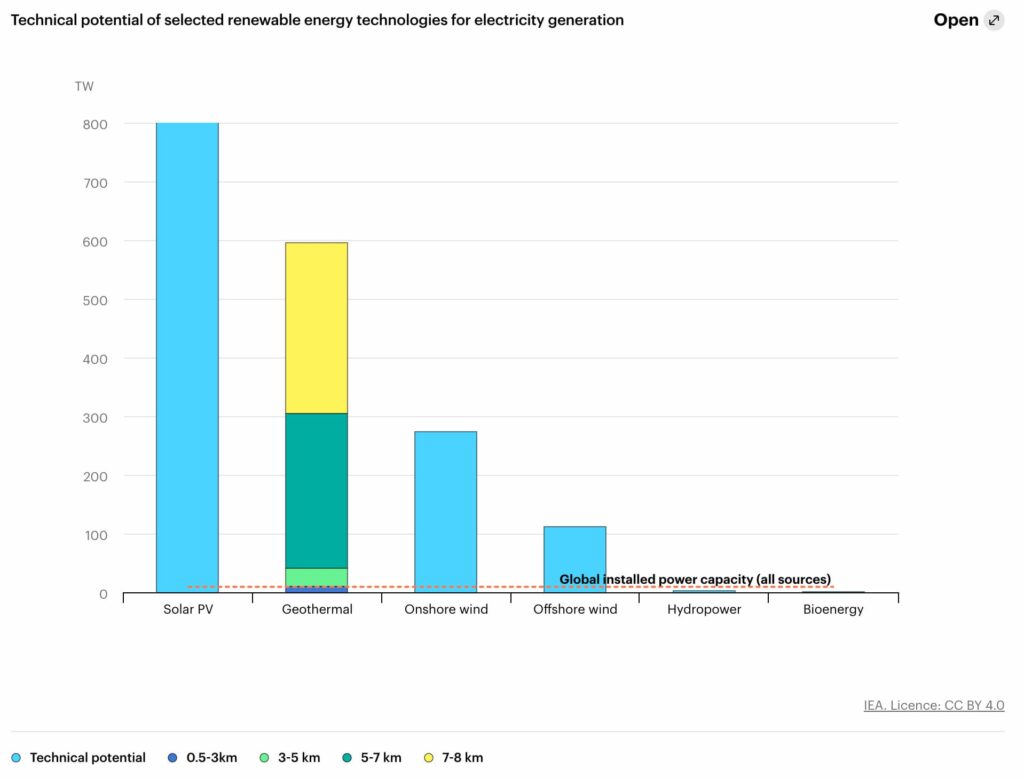Geothermal energy has recently experienced major breakthroughs that significantly expand its role in future climate-friendly energy supply. However, it remains capital-intensive and highly long-term.
Renewable energy is the Achilles’ heel of the green transition. Wind energy was the first wave, followed by solar power. For a long time, it was expected that wave energy would be next. But in recent years, geothermal energy has seen advances that greatly enhance its potential.
Geothermal Energy is Renewable and Ultra-Stable ...
The Earth’s interior has temperatures ranging from 1,000 to 5,000 degrees Celsius. However, the outer 30–35 kilometers are covered by a crust. In this layer, the heat is constant, as it is the result of radioactive decay from elements such as uranium, thorium, and potassium. This decay will remain stable for at least another billion years.
This makes the overall geothermal energy potential ultra-stable. Most other renewable energy sources depend on either the sun shining or the wind blowing. The climate benefit is significant, as geothermal does not need to be supplemented with, for example, gas turbines during peak load. There are also major geopolitical advantages, as geothermal energy is independent of imported oil, gas, or uranium.
Geothermal energy is primarily extracted by recirculating saltwater between underground reservoirs and surface turbines or heat exchangers. Heat exchangers are necessary when drilling depths are “only” a few kilometers deep, such as in Denmark. In these cases, the return water temperature is below 100 degrees Celsius.
… and Suitable for Electricity Production
However, higher temperatures and pressures are needed to drive turbines for electricity generation. In many locations, this requires drilling deeper than 5 kilometers, but drilling costs rise exponentially with depth. The Earth’s crust is, on average, 30–35 kilometers thick.
Electricity, though, offers the highest energy efficiency, and for a long time, geothermal was considered feasible only in a few places on Earth. As a result, geothermal energy currently accounts for less than 0.3% of global energy production.
- In Iceland, the share is much higher due to volcanic activity near the surface.
- But there are also cracks and pockets in the Earth’s crust in countries like New Zealand, Indonesia, Turkey, and China.
- Elsewhere, geothermal energy can be extracted where continental plates meet and create pockets just a few kilometers deep. This is the case in Kenya’s Rift Valley, which today produces half (1 GW) of Kenya’s electricity. Kenya is estimated to have a potential of at least 10 GW, which could make the country a major energy exporter. This provides substantial regional geopolitical soft power.
Recent Major Developments ...
In recent years, two key developments have driven progress:
- Discovery of new locations with crustal pockets
- Development of promising new drilling technologies
… Include Methods for Finding Suitable Drilling Sites
The Earth’s crust is highly uneven, but mapping small, suitable pockets has been difficult. Recently, companies like Zanskar have used AI models to predict where such pockets may exist. The generative component of AI has proven effective at synthesizing data from seismographs and acoustic sensors.
… and New Drilling Technologies
Elsewhere in the world, geothermal energy is moving closer to viability. The deepest hole to date, on the Kola Peninsula near Murmansk, reached 12 km and took over 20 years to drill. Drilling to such depths is extremely costly, as the rock layers often consist of hard stone. But new drilling technologies may overcome some of these obstacles. For example, Quaise Energy uses electromagnetic microwave radiation (gyrotron) to melt and vaporize rock without physical drill bits, which would otherwise wear out.
Geothermal energy also requires porous rock underground for heat exchange. To minimize environmental impact, it’s preferable to have naturally occurring water available for recirculation. Companies like Fervo Energy are addressing this by using hydraulic fracturing, technology known from shale gas extraction, which creates fissures by pumping a fluid mixed with sand or hard grains and chemicals at high pressure. However, this method also carries long-term environmental risks, such as groundwater contamination.
This Has Sparked New Expectations for Geothermal Energy ...
These developments have led to a boom in the industry, attracting significant investment capital. The International Energy Agency (IEA) predicts that global geothermal electricity production will grow from 15 GW in 2020 to over 800 GW by 2050. In their Future of Geothermal Energy report, the IEA notes that “next-generation geothermal systems could provide up to 8% of the global electricity supply by 2050.” This does not even include the geothermal heat used in combined heat and power plants. The IEA expects that 90% of geothermal energy will be extracted from depths greater than 5 kilometers, see graph below.
However, the high investment required for geothermal energy remains an Achilles’ heel. A single borehole can cost upwards of USD 100 million, if the subsurface conditions are favorable. In comparison, a gas generator costs around USD 1 million.
… But Requires VERY Long-Term Investors
Therefore, geothermal energy investors must be very long-term in their outlook. While they can expect stable and high returns, no one knows what the alternative price of energy will be in 5, 15, or 25 years. That price will determine whether it was a good investment. Other renewable energy types may have taken quantum leaps in the meantime—such as small modular thorium MSR reactors or fusion energy.
Additionally, geothermal energy poses a greater risk of local environmental contamination, as it uses large volumes of water. That water becomes polluted—similar to fracking, and may seep into groundwater reserves.


